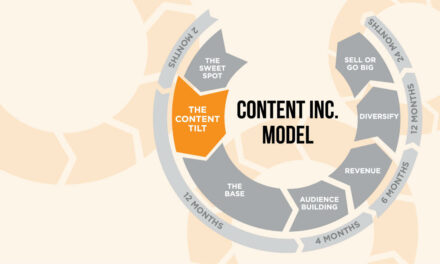Everyone in the content business knows that mobile use is on the rise, and many content providers are rushing to move their content to applications. Earlier this year, Apple announced the 10 billionth download in the App Store, and the 2-year-old Android Market already offers more than 100,000 apps for download. Despite the increasing adoption of mobile content in our personal lives, apps may not be on the menu this year for most enterprise organizations. This is because work-related adoption presents barriers that many industries aren’t quite ready to deal with.
FreePint Ltd., a publisher of resources for the business information industry, conducted a two-part project and released reports in September and January. “Enterprise Market for Mobile Content”-released last September-and “User Interest in Mobile Content”-released in January-explore individual and enterprise interest in mobile content. Robin Neidorf, director of research for FreePint, says she found that people are embracing mobile use on an individual basis, but they aren’t at the point yet where they know what to expect in the enterprise.
Industries represented in the “Enterprise Market for Mobile Content” study include healthcare, scientific manufacturing, law, finance, government, and consulting. The healthcare and financial services-two highly regulated industries with data security concerns-proved to have two very different perspectives on going mobile, according to the report. Healthcare is embracing mobile technology, even using tablet devices at the point of care, while financial services showed little movement toward adaptation.
“Healthcare was a real surprise to me,” says Neidorf. “I wasn’t expecting that result at all, but what seems to be happening is, despite the fact that there are significant challenges, there’s such a need for workers to be mobile that people within that industry are innovating at a more accelerated rate than you see in other industries.” Many doctors are accessing everything from patient records to diagnostic tools on tablets.
For most industries, though, the biggest barrier to going mobile is concern about security. Because mobility is a new concept for businesses, there are no set expectations yet for its use. For Neidorf, there are uncertainties when it comes to a number of issues, including who is responsible if there is a data breach via mobile devices. Would it be in the hands of the cellular carrier, the individual using the handset, or the network providers?
“Being able to set and maintain industry-wide standards around how that data is managed is going to go a long way in helping these organizations feel a lot more comfortable with going mobile,” says Neidorf.
Security isn’t the only barrier to going mobile, though. Many companies find it difficult to decide which devices to use when making the shift to a mobile work force. Neidorf refers to the device that people prefer to use-rather than the ones they receive from employers-as a side-pocket device. You often find that users have an iPhone for personal use and a BlackBerry-which has built a large corporate userbase-for work.
“The Apple system is based on an ad model which doesn’t tend to work very well in an enterprise environment,” says Neidorf. “That said, there are a lot of senior executives out there that really love their iPads and are putting a lot of pressure on their organizations to figure out, ‘How do we let me use this, my preferred tool in this environment?'”
According to FreePint’s research, many enterprises are still not distributing devices to the work force. Respondents with both basic and smart mobile phones were more than twice as likely to have their own equipment than to be carrying something provided by an employer. Of the same respondents, when it came to what their mobile devices were used for, business email use was low on the list at No. 4, with personal texting and personal email being most popular.
However, going mobile isn’t all about distributing devices. Many companies are still figuring out which content and business information to make available through mobile channels. “I’m a pretty mobile person and I would have a hard time thinking about what is absolutely business critical that I have to get on my handset,” says Neidorf. What people need or want access to at their workstations is different than what they need or want on their mobile devices.
In the study, news and alerts were among some of the most popular content types to provide on mobile devices. Many companies already provide this kind of content via email, which can also be accessed on mobile devices. One business though found that implementing a mobile news and alerts system offered a desirable sophistication, allowing users to set up their own alerts and read articles that are formatted properly for mobile.
Another concern for organizations is the cost of mobility. According to Neidorf, there are too many question marks around data charges. Even if a user feels like he or she has access to particular data via a mobile device, he or she might opt to access that data through a computer to avoid unknown charges. “I was at a conference in London in December and a lot of people that had iPads and iPhones completely shut them off because they were so afraid of getting hit with huge data charges,” says Neidorf. “You just don’t know what you’re downloading. So those kinds of costs are very much a concern.”
Though mobile enterprise adoption is coming, there is no definitive answer as to when it will be widespread. According to Neidorf, the time between initial introduction and widespread adoption gets smaller and smaller with each technological advance. “It’s definitely going to happen, probably faster than most people anticipate, but it certainly is not going to happen quite as fast as a lot of content providers and vendors wanted it to,” she says.
With the economy crawling out of a recession, the appetite for investment remains small for some companies. This in turn could slow willingness to adopt mobility. While Neidorf expects changes, she doesn’t expect mobile in the enterprise to be predominant anytime soon.
“What I do expect to see in the coming year is more pilot projects, more innovations in companies where
there’s a high interest in early adoption,” says Neidorf. “But probably not that wide-spread, everybody is going to have it on their handsets in the next 2 years. I don’t see that happening.”
(www.apple.com; www.blackberry.com; www.freepint.com; https://market.android.com)







